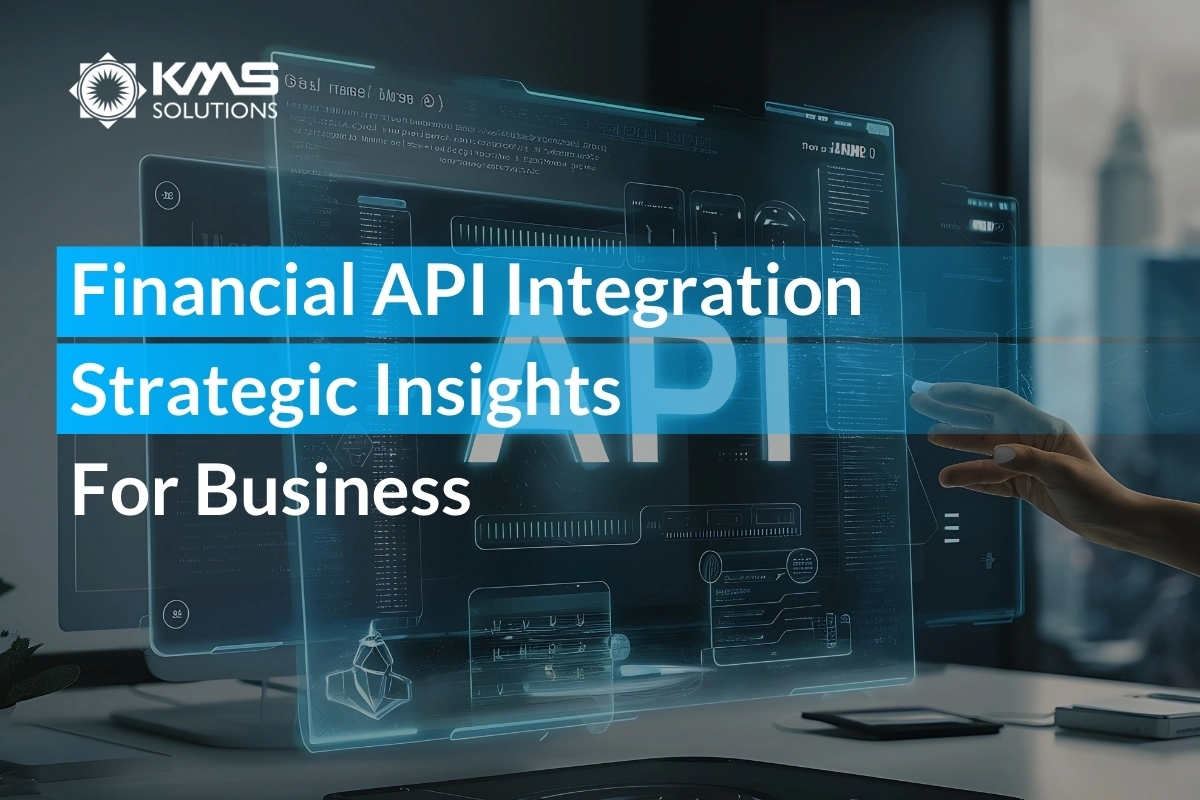In today’s rapidly evolving financial landscape, Financial API integration stands as a pivotal innovation, enabling smooth connectivity between various financial services and applications. Financial API integration allows organizations to connect seamlessly with various financial institutions, payment systems, and third-party services, enabling the efficient exchange of data and the automation of financial processes.
This integration not only facilitates real-time access to vital financial information but also supports innovative solutions such as open banking, digital payments, and personalized financial products. In this article, we will explore the strategic insights of financial API integration for businesses, including its benefits and key strategies to integrate API seamlessly.
Read more: Financial System Implementation: 9 Best Strategies To Implement A Financial System
What is API Integration In Finance?
What is API Integration?
API (Application Programming Interfaces) technology is the bridge between the customer-facing front end – the software or application interface that users interact with directly – and the back end, where all the heavy lifting happens and the logic is stored. Interacting with an API, along with the part of the user interface that grants access to it, is crafted with the user experience in mind since it represents the brand, service, or product to the customers.
Read more: The Ultimate Guide to API Gateway Service Integration in 2024
What is Financial API Integration?
In the world of finance, where web and mobile platforms dominate, seamless API integration is the backbone of modern software solutions. Let’s break it down: API integration in finance is a set of guidelines, protocols, and tools that allow different software systems to communicate and perform various tasks effortlessly.
Read more: Expert API Integration for Your Business
By utilizing financial APIs, businesses can integrate diverse financial systems, creating a unified and efficient operational environment. These APIs facilitate real-time data exchange, support secure transactions, and allow for the incorporation of third-party services. This not only optimizes processes but also enhances customer experiences by providing quick and reliable financial services.
Read more: 3rd Party API Integration: Ultimate Guide For Your Banking Software
Financial API Integration is essential for modernizing financial operations. It helps businesses stay competitive by enabling rapid adaptation to market changes and regulatory requirements. By connecting disparate systems, financial APIs provide a robust framework for innovation, allowing companies to introduce new services and features with minimal disruption.
Read more: Financial API Integration: Strategic Insights for Business
Moreover, the implementation of financial API integration supports compliance with industry standards, ensuring secure and reliable operations. This is crucial in the financial sector, where data security and regulatory compliance are paramount. Businesses can use APIs to automate compliance checks, reduce manual errors, and ensure that all transactions meet the necessary legal requirements.
How Does API Work in the Financial Services Industry?
The banking API embedded in digital wallet enables several key functions:
- Customers can request to open bank accounts directly from their e-wallet. They might not even know which bank handles their request. The financial API processes this request by connecting to its banking system and initiating account creation.
- The system checks API keys to validate requests, ensuring security and authenticity.
- Once verified, the API reads data from the bank or performs necessary actions, like opening an account, in real time.
- After processing, the API sends back a response to the e-wallet, informing the customer of the request’s success or failure.

Types of financial API integrations
There are five main types of financial API integrations, including:
Banking APIs
Banking APIs connect financial institutions with third-party applications, providing access to banking services and data. These APIs are pivotal for developing modern fintech solutions and enhancing customer experiences.
Read more: 7-Step Checklist for Effective Finance System Integration
Common use cases include:
- Open banking: Allowing third-party developers to build applications and services around financial institutions, fostering innovation and competition.
- Account management: Enabling users to view and manage their bank accounts, including balance inquiries and transaction histories.
- Fund transfers: Facilitating money transfers between accounts, both within the same bank and across different banks.
- Financial data: Providing access to detailed financial data and analytics, helping users and businesses make informed decisions.
Read more: 5 Minutes to Understand Why API Testing is Essential for Open Banking
Payment Gateway APIs
Payment Gateway APIs are essential for facilitating online transactions. They enable businesses to accept various forms of payments, such as credit cards, debit cards, and digital wallets, through secure and efficient processes. This type of API ensure smooth transactions and improve customer experience. Key functionalities typically include:
- Transaction processing: Handling payment requests and ensuring the secure transfer of funds between the buyer and seller.
- Fraud detection: Incorporating fraud detection and prevention mechanisms to identify and mitigate potential fraudulent activities.
- Currency conversion: Allowing payments in multiple currencies, which is crucial for international transactions.
- Recurring billing: Supporting subscription-based services with automatic billing cycles.
Read more: Payment Gateway API Integration: Definition, How It Works and Benefits
Investment APIs
Investment APIs grant access to various financial markets and investment platforms, empowering users to manage their portfolios and make informed investment decisions. Key features include:
- Market data: Providing real-time and historical data on stocks, bonds, mutual funds, and other financial instruments.
- Trading execution: Enabling the execution of buy and sell orders on behalf of the user.
- Portfolio management: Offering tools for tracking and analyzing investment portfolios, including performance metrics and risk assessments.
- Robo-advisors: Automating investment advice and portfolio management based on user preferences and risk tolerance.
Lending APIs
Lending APIs streamline the process of borrowing and lending money, making it more accessible and efficient. These APIs are vital for online lending platforms, peer-to-peer lending, and traditional banking institutions. They typically offer:
- Loan applications: Simplifying the loan application process with digital forms and automated credit checks.
- Credit scoring: Integrating with credit bureaus to assess the creditworthiness of applicants.
- Loan management: Handling the disbursement of funds, repayment schedules, and collections.
- Risk assessment: Utilizing advanced algorithms to evaluate the risk associated with lending to a particular borrower.
Insurance APIs
Insurance APIs facilitate the integration of insurance services into various platforms, enhancing customer experience and operational efficiency. These APIs provide functionalities such as:
- Policy management: Allowing users to view and manage their insurance policies, including renewals and updates.
- Claims processing: Streamlining the submission, tracking, and settlement of insurance claims.
- Quote generation: Providing instant insurance quotes based on user inputs and risk assessments.
- Underwriting: Automating the underwriting process by analyzing data to determine the terms and pricing of insurance policies.

API Integration: Benefits for Bank and Fintechs
Now let’s dive into the specific pros that API banking brings to banks and the fintech sector in general:
Core Benefits of API Banking for Banks
More and more users are opting to check their bank accounts online or via their phones instead of heading to an ATM. Digitizing services through API banking solutions allows banks to better serve those customers and those who live far from physical branches. Here are the standout benefits of API integration in banking:
- APIs ensure that interactions are effortless and intuitive.
- APIs streamline the flow of data, making information exchange quick and error-free.
- APIs enable banks to offer a variety of services in one place.
- With APIs, customers can complete multiple tasks in a single visit.
- APIs open up opportunities for collaboration with fintechs and other businesses.
- APIs help banks launch new products and services more quickly.
- APIs pave the way for developing cutting-edge financial products that meet evolving customer needs.
- APIs pave the way for developing cutting-edge financial products that meet evolving customer needs.
Read more: The Power of Banking System Integration: How Businesses Unlock Efficiency and Growth
Core Benefits of API Banking for Fintechs
In the fast-paced world of fintech, offline work is practically obsolete. Fintech startups also often lack banking licenses, preventing them from offering direct financial services. To bridge this gap, they partner with established financial institutions through APIs. Building an API solution from scratch is seldom feasible due to its complexity, cost, and time requirements.
Instead, many companies rely on data aggregators. These providers consolidate financial data, such as bank accounts, credit cards, loans, and investments, into one accessible platform. For example, Plaid offers APIs that enable businesses to seamlessly deliver financial services to their customers.
The advantages of API banking for fintech firms include:
- APIs unlock new collaboration opportunities and revenue channels.
- APIs streamline adherence to financial regulations.
- Integrating banking services allows fintech companies to offer a wider array of products.
- APIs create a seamless, user-friendly interface.
- Efficient and reliable API integrations build customer trust and foster loyalty.
Read more: Open Banking Implementation Checklist: What You Need to Prepare for 2025
How to Integrate a Finance API
Integrating a Finance API might feel like climbing Everest, but with the right moves, it’s more like a walk in the park. Here’s your go-to guide to make it happen with ease:
Pre-Integration Steps
Step 1. Understanding Your Needs
Before jumping in, get clear on why you need the API. Are you aiming to boost customer service, streamline your operations, or roll out new financial products? Pinpointing your goals will help you pick the right API and plan your integration strategy effectively.Step2. Picking the Right API Provider
To choose an API provider that aligns with your business goals, you should look for reliability, solid documentation, and top-notch support. Check out popular names like Plaid, Yodlee, and BBVA, compare their features, pricing, and reviews to make a smart choice. Here’s a quick list of some well-regarded banking API providers:- Plaid: A data network and payments platform with a user-friendly interface and extensive financial institution coverage.
- Tink (Visa): Known for strong security and open banking solutions in Europe.
- Yodlee: Focuses on data aggregation and financial wellness tools, perfect for those specific needs.
- TrueLayer: Offers real-time transaction data with a developer-friendly API, another solid European choice.
- Salt Edge: A global open banking API solution with a B2B focus.
Step 3. Security First
In the world of banking, security is everything. Ensure your chosen API provider follows robust security protocols. Even though these providers typically operate in a tightly regulated space and likely adhere to top security standards, always verify first.Integration Steps
Step 4. Dive into the Documentation
Kick things off by thoroughly reviewing the API documentation from your provider. This will give you a clear picture of how the API works, available endpoints, and usage instructions.
Step 5. Setting Up Your Dev Environment
Next, get your development environment in order. This involves installing the necessary software, libraries, and tools. Make sure your system is ready to handle API requests and responses smoothly.
Step 6. API Testing
With your development environment primed, it’s time to consider API software testing. This critical phase ensures your application functions seamlessly and delivers accurate results.
Start by constructing comprehensive test cases that cover a wide range of scenarios, including functional, performance, security, etc. Simulate different user behaviors, input variations, and error conditions. Pay close attention to data accuracy, response times, and error-handling mechanisms.
Read more: Effective API Testing: Key Strategies and Tools for 2024
Step 7. Live Deployment
When you’re confident with your testing, it’s time to go. Roll out the API integration in a controlled manner, starting with a limited audience before scaling up. Keep a close eye on the system for any hiccups and be ready to tackle them swiftly.

Challenges and Solutions in Financial API Integration
Challenges
Fintech startups are leveraging APIs to disrupt traditional banking with fresh products and services. While they’re agile and inventive, they often lack the resources to develop APIs from the ground up, unlike the big banks that have been perfecting their API game for years, if not decades. This resource gap presents some hefty challenges, such as:
- Security concerns: Fintechs need to ensure their APIs are ironclad against breaches and unauthorized access. This requires hefty investment in top-notch security protocols and constant vigilance.
- Regulatory compliance: Navigating the labyrinth of financial regulations is no small feat. APIs must adhere to various laws and standards, which can differ widely by region.
- Data management: Maintaining accurate, reliable, and real-time data exchange is crucial but tough, especially for smaller fintechs without a solid data infrastructure.
- Interoperability: Melding APIs with existing banking systems and third-party apps can be a nightmare due to varying standards and technologies.
Scalability: As user bases grow, APIs need to handle increased load and performance demands, posing a significant technical challenge.
Solutions from KMS
At KMS Solutions, we’re all about turning those API integration challenges into opportunities. We offer a suite of solutions tailored to ensure fintechs and banks can fully exploit the power of APIs:
Embedded Payment
Our embedded payment solutions let fintechs integrate payment processing directly into their apps. We support various payment methods, provide secure transaction processing, and ensure compliance with regulatory standards. The result? A seamless, secure payment experience that boosts customer satisfaction and trust.
Stringent Security and Compliance
KMS’s commitment to security is underpinned by our adherence to industry regulations such as the General Data Protection Regulation (GDPR) and the Payment Card Industry Data Security Standard (PCI DSS). These frameworks guide our approach to data handling, safeguarding customer information at every touchpoint.
Furthermore, our team boasts Certified Banking Domain Professional (CBDP) credentials, demonstrating our deep understanding of the banking industry and its regulatory landscape. This expertise translates into secure and compliant financial API integration solutions that instill trust in your customers.
A Complete Range of API Testing Capabilities
- Financial API testing
At KMS Solutions, we understand the critical role of rigorous testing in ensuring the reliability, security, and performance of your financial API integration. Our testing services encompass:
- API Performance Testing
Evaluating your API’s response times, throughput, and resource utilization under various load conditions is crucial for delivering optimal user experiences.
- API Functional Testing
To guarantee your API meets its intended specifications, our API functional testing meticulously examines endpoints, parameters, response codes, and data formats.
- API Security Testing
KMS’s API security testing identifies vulnerabilities and weaknesses to safeguard your API against common threats like unauthorized access, injection attacks, and data breaches. We help you build robust security measures to protect your customers’ trust.
Read more: The Role of Automation in API Security Testing
- API Integration Testing
Ensuring smooth interaction between different components and APIs is essential for a smooth user experience. Our API integration testing validates data exchange, synchronization, and error handling to prevent disruptions and ensure accurate data flow within your ecosystem.
- API Reliability Testing
API reliability testing assesses your API’s performance under various conditions, including high loads, concurrent requests, and network disruptions. We help you identify potential issues and build a robust and dependable API.
- API Interoperability Testing
API interoperability testing verifies compatibility with third-party APIs, client applications, and backend services to ensure smooth data exchange and prevent integration-related issues.
- API Regression Testing
Our API regression testing detects unintended changes in API behavior after updates or modifications. By identifying regressions early on, we help you prevent disruptions and maintain a stable API.
Read more: The Role of Financial Technology Consulting Services in Modern Banking
Use Cases of APIs in FinTech
Payment API Applications
Online Transactions and Payments:
- Facilitate secure online transactions for customers.
- Allow customers to pay for goods and services effortlessly.
Fund Transfers:
- Enable seamless fund transfers between accounts.
- Provide secure, instantaneous transactions for enhanced user convenience.
Account Information API Applications
Financial Management Applications:
- Integrate with financial management tools.
- Provide users with real-time account information for better budgeting and financial planning.
Transaction Monitoring and Alerts:
- Enable real-time transaction monitoring.
- Send notifications for specific transactions or balance changes, ensuring vigilant financial management.
Open Banking API Applications
Personal Finance and Budgeting Tools:
- Access and analyze customer bank account data.
- Offer tailored budgeting advice based on spending patterns.
Invoice Financing:
- Use open banking APIs to verify invoices and assess creditworthiness.
- Streamline financing options and payment processes for vendors and buyers.
Conclusion
When it comes to the financial sector, there is no question that APIs are a driving force of innovation. At KMS Solutions, we excel in providing robust API and application integration capabilities designed specifically for financial services. Our comprehensive suite of testing services ensures that your APIs perform flawlessly under diverse conditions, offering smooth integration and enhanced functionality.
Ready to tap into the endless possibilities with financial API integration? Just get in touch with us, and our experts will help you with exceptional solutions soon!
FAQs
What is the meaning of API in the context of Open Banking?
How do Banking-as-a-Service (BaaS) and Banking APIs differ?
Banking-as-a-Service (BaaS) is a comprehensive model that allows third-party companies to offer banking services by leveraging the infrastructure of existing banks. It includes a suite of services like payment processing, lending, and account management. Banking APIs, on the other hand, are the specific interfaces that facilitate the technical integration and data exchange necessary for BaaS and other financial services.
What steps are involved in creating a bank using APIs?
Step 1: Obtain necessary licenses and adhere to all relevant financial regulations.
Step 2: Define the scope and functionality of required APIs.
Step 3: Develop APIs for secure and efficient data exchange and transaction processing.
Step 4: Integrate APIs with various banking systems and third-party applications.
Step 5: Implement strong security protocols to protect customer data.
Step 6: Thoroughly test APIs to ensure functionality and security.
Step 7: Deploy APIs and continuously monitor performance.
Step 8: Provide robust support to address any issues and ensure smooth operation.
Which APIs are commonly implemented by banks?
Banks commonly implement several types of APIs, including:
- Payment APIs
- Account Information APIs
- Open Banking APIs
- Credit Scoring APIs
- KYC (Know Your Customer) APIs
What are the standard practices for APIs in banking?
Standard practices for banking APIs include:
- Security and Compliance: Implementing strong encryption, authentication, and compliance with regulatory standards.
- Robust Documentation: Providing clear and comprehensive API documentation for developers.
- Scalability and Performance: Ensuring APIs are scalable and perform efficiently under various loads.
- User Consent and Data Privacy: Ensuring customer data is accessed and used with explicit consent and privacy protections.
- Monitoring and Support: Continuously monitoring API performance and providing support to address any issues.









